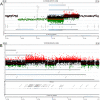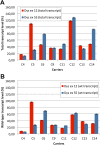Genetic characterization in symptomatic female DMD carriers: lack of relationship between X-inactivation, transcriptional DMD allele balancing and phenotype
- PMID: 22894145
- PMCID: PMC3459813
- DOI: 10.1186/1471-2350-13-73
Genetic characterization in symptomatic female DMD carriers: lack of relationship between X-inactivation, transcriptional DMD allele balancing and phenotype
Abstract
Background: Although Duchenne and Becker muscular dystrophies, X-linked recessive myopathies, predominantly affect males, a clinically significant proportion of females manifesting symptoms have also been reported. They represent an heterogeneous group characterized by variable degrees of muscle weakness and/or cardiac involvement. Though preferential inactivation of the normal X chromosome has long been considered the principal mechanism behind disease manifestation in these females, supporting evidence is controversial.
Methods: Eighteen females showing a mosaic pattern of dystrophin expression on muscle biopsy were recruited and classified as symptomatic (7) or asymptomatic (11), based on the presence or absence of muscle weakness. The causative DMD gene mutations were identified in all cases, and the X-inactivation pattern was assessed in muscle DNA. Transcriptional analysis in muscles was performed in all females, and relative quantification of wild-type and mutated transcripts was also performed in 9 carriers. Dystrophin protein was quantified by immunoblotting in 2 females.
Results: The study highlighted a lack of relationship between dystrophic phenotype and X-inactivation pattern in females; skewed X-inactivation was found in 2 out of 6 symptomatic carriers and in 5 out of 11 asymptomatic carriers. All females were characterized by biallelic transcription, but no association was found between X-inactivation pattern and allele transcriptional balancing. Either a prevalence of wild-type transcript or equal proportions of wild-type and mutated RNAs was observed in both symptomatic and asymptomatic females. Moreover, very similar levels of total and wild-type transcripts were identified in the two groups of carriers.
Conclusions: This is the first study deeply exploring the DMD transcriptional behaviour in a cohort of female carriers. Notably, no relationship between X-inactivation pattern and transcriptional behaviour of DMD gene was observed, suggesting that the two mechanisms are regulated independently. Moreover, neither the total DMD transcript level, nor the relative proportion of the wild-type transcript do correlate with the symptomatic phenotype.
Figures






Similar articles
-
Determining the role of skewed X-chromosome inactivation in developing muscle symptoms in carriers of Duchenne muscular dystrophy.Hum Genet. 2016 Jul;135(7):685-98. doi: 10.1007/s00439-016-1666-6. Epub 2016 Apr 21. Hum Genet. 2016. PMID: 27098336 Review.
-
Clinical and genetic characterization of manifesting carriers of DMD mutations.Neuromuscul Disord. 2010 Aug;20(8):499-504. doi: 10.1016/j.nmd.2010.05.010. Epub 2010 Jul 13. Neuromuscul Disord. 2010. PMID: 20630757 Free PMC article.
-
Genetic and clinical specificity of 26 symptomatic carriers for dystrophinopathies at pediatric age.Eur J Hum Genet. 2013 Aug;21(8):855-63. doi: 10.1038/ejhg.2012.269. Epub 2013 Jan 9. Eur J Hum Genet. 2013. PMID: 23299919 Free PMC article.
-
Symptomatic female carriers of Duchenne muscular dystrophy (DMD): genetic and clinical characterization.J Neurol Sci. 2014 Jan 15;336(1-2):36-41. doi: 10.1016/j.jns.2013.09.036. Epub 2013 Oct 5. J Neurol Sci. 2014. PMID: 24135430
-
Cardiac Involvement in Dystrophin-Deficient Females: Current Understanding and Implications for the Treatment of Dystrophinopathies.Genes (Basel). 2020 Jul 8;11(7):765. doi: 10.3390/genes11070765. Genes (Basel). 2020. PMID: 32650403 Free PMC article. Review.
Cited by
-
Determining the role of skewed X-chromosome inactivation in developing muscle symptoms in carriers of Duchenne muscular dystrophy.Hum Genet. 2016 Jul;135(7):685-98. doi: 10.1007/s00439-016-1666-6. Epub 2016 Apr 21. Hum Genet. 2016. PMID: 27098336 Review.
-
Uniform sarcolemmal dystrophin expression is required to prevent extracellular microRNA release and improve dystrophic pathology.J Cachexia Sarcopenia Muscle. 2020 Apr;11(2):578-593. doi: 10.1002/jcsm.12506. Epub 2019 Dec 17. J Cachexia Sarcopenia Muscle. 2020. PMID: 31849191 Free PMC article.
-
Quantitative Muscle MRI and Clinical Findings in Women With Pathogenic Dystrophin Gene Variants.Front Neurol. 2021 Sep 3;12:707837. doi: 10.3389/fneur.2021.707837. eCollection 2021. Front Neurol. 2021. PMID: 34539555 Free PMC article.
-
The DMD locus harbours multiple long non-coding RNAs which orchestrate and control transcription of muscle dystrophin mRNA isoforms.PLoS One. 2012;7(9):e45328. doi: 10.1371/journal.pone.0045328. Epub 2012 Sep 21. PLoS One. 2012. PMID: 23028937 Free PMC article.
-
Dystrophin myonuclear domain restoration governs treatment efficacy in dystrophic muscle.Proc Natl Acad Sci U S A. 2023 Jan 10;120(2):e2206324120. doi: 10.1073/pnas.2206324120. Epub 2023 Jan 3. Proc Natl Acad Sci U S A. 2023. PMID: 36595689 Free PMC article.
References
-
- Moser H, Emery AE. The manifesting carrier in Duchenne muscular dystrophy. Clin Genet. 1974;5(4):271–284. - PubMed
-
- Norman A, Harper P. A survey of manifesting carriers of Duchenne and Becker muscular dystrophy in Wales. Clin Genet. 1989;36(1):31–37. - PubMed
-
- Hoogerwaard EM, Bakker E, Ippel PF, Oosterwijk JC, Majoor-Krakauer DF, Leschot NJ, Van Essen AJ, Brunner HG, van der Wouw PA, Wilde AA, de Visser M. Signs and symptoms of Duchenne muscular dystrophy and Becker muscular dystrophy among carriers in the Netherlands: a cohort study. Lancet. 1999;353:2116–2119. doi: 10.1016/S0140-6736(98)10028-4. - DOI - PubMed
Publication types
MeSH terms
Substances
LinkOut - more resources
Full Text Sources
Other Literature Sources
Research Materials
Miscellaneous

